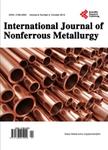Mechanism of Silver Nanoparticles Deposition by Electrolysis and Electroless Methods on a Graphite Substrate
Mechanism of Silver Nanoparticles Deposition by Electrolysis and Electroless Methods on a Graphite Substrate作者机构:Chemocal and Electrochemical Treatment Lab. Mineral Processing Dept. Central Metallurgical Research and Development Institute (CMRDI) El-Flezzat Str. El-Tebbin Cairo Egypt Control and Surface Protection Lab (CMRDI) El-Flezzat Str. El-Tebbin Cairo Egypt
出 版 物:《International Journal of Nonferrous Metallurgy》 (有色冶金(英文))
年 卷 期:2022年第10卷第1期
页 面:1-14页
学科分类:080603[工学-有色金属冶金] 08[工学] 0806[工学-冶金工程]
主 题:Silver and Chromium Nanoparticles Electrolysis Electroless Deposition Chemical Deposition and Pulse Current Graphite Substrate
摘 要:This study shows a silver electrodeposition model (EDM) on a graphite substrate. The electrolyte was a 0.01 M solution of pure silver and chromium nitrate using an electrolyzing cell. EDC with current density up to 20 mA/cm2 and 15 mV and pulse current were studied. Results revealed that silver deposited at a rate of 0.515 mg/cm2/min with 12 mA/cm2 that decreases to 0.21 and 0.16 mg/cm2·min with the decrease of current density to 6 and 5 mA/cm2 respectively. The model postulates that silver ions (a) were first hydrated before diffusing (b) from the solution bulk to the cathode vicinity, The next step (c) involved the chemical adsorption of these ions on certain accessible sites of the graphite substrate (anode), The discharged entities (d) adhere to the graphite surface by Van der Vales force. Silver ions are deposited because the discharge potential of silver is low (0.38 mV) as compared to other metal ions like chromium (0.82 mV). Pulse current controls silver deposition due to flexibility in controlling steps (a)-(c) of the deposition mechanisms. Parameters like current density, current on-time, current-off time, duty cycle (ratio of current on time and total pulse time) and pulse frequency influenced the shape and size of the deposits. Step (b) suggested that silver particles were deposited in a monolayer thickness. The silver layer turned multiple after fully satisfying the accessible sites with the monolayer. The activation energy ΔE value amounts to 86.32 kJ/mol/K. At high temperature and current density, homogeneous diffusion occurs.



